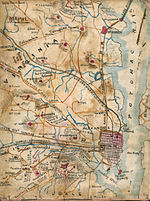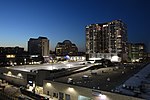Arlington Ridge, Virginia

Arlington Ridge is an neighborhood in Arlington County, Virginia, United States. It is bordered on the north by The Pentagon, on the west by the Army Navy Country Club, and on the south the City of Alexandria. The main thoroughfare is the eponymous Arlington Ridge Road, a mansion-lined boulevard that, due to its high elevation, offers picturesque views of Washington, D.C., and the surrounding areas. Also known simply as "The Ridge", this community is home to two historical points of interest: the Hume School (National Register of Historic Places), currently the site of the Arlington Country Historical Society and Museum, and Fort Scott (Historic District), currently the site of Fort Scott Park.
Excerpt from the Wikipedia article Arlington Ridge, Virginia (License: CC BY-SA 3.0, Authors, Images).Arlington Ridge, Virginia
South Arlington Ridge Road, Arlington
Geographical coordinates (GPS) Address Nearby Places Show on map
Geographical coordinates (GPS)
| Latitude | Longitude |
|---|---|
| N 38.853055555556 ° | E -77.068333333333 ° |
Address
South Arlington Ridge Road 2303
22202 Arlington
Virginia, United States
Open on Google Maps









